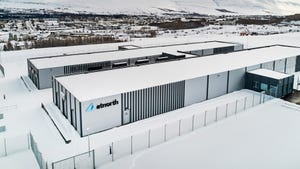As Bitcoin Grows Mainstream, Data Center Provider Opportunity Widens
Amid price declines, Bitcoin miners see a future shaped by transaction fees and a more enterprise-friendly mining data center network
October 9, 2014

As sharp price declines wreak havoc with the economics of Bitcoin mining, some entrepreneurs see a shift to transaction fees as the future of the virtual currency. This evolution came into focus this week, as the lead developer proposed revising Bitcoin's core code to increase the volume of transactions on the network.
A shift from mining rewards to transaction fees has implications for the data center industry, which could gain more business from industrial Bitcoin miners if the facilities supporting the network need to be enterprise-friendly. That would mark a shift from the current practice, in which the Bitcoin network infrastructure is split between data centers and no-frills hashing centers featuring high-density hardware and low-reliability power infrastructure, often housed in former warehouses.
As marquee brands like PayPal and Dell embrace the virtual currency, the global Bitcoin miner network has plenty of data-crunching capacity. But are America's largest merchants and payment processors comfortable trusting their customer experience to mining rigs sitting in warehouses halfway around the world?
"My belief is that if you’re Michael Dell and your revenues from bitcoin become meaningful, you may want to know where your transactions are being processed," said Dave Carlson, the CEO of MegaBigPower, one of North America's largest mining operations. "You may not want to rely upon a mine in China. I believe there will be premium processing contracts, so merchants will know exactly where their transactions are processed."
Carlson believes e-commerce will create a major opportunity for dedicated Bitcoin mining operations. He expects to deploy at least 20 megawatts of capacity in central Washington state in coming months -- and perhaps much more -- as MegaBigPower introduces new hardware optimized for industrial-scale mining and energy efficiency.
Shakeout for the mining sector?
Carlson is a pioneer in industrial-scale mining, operating one of the sector's largest Bitcoin mining facilities in a warehouse in central Washington. He's seen the network's processing power (hashrate) soar from 2 gigahashes per second last October to more than 300 gighashes per second, with much of that power controlled by multi-megawatt mines in areas like China, Sweden and the Ukraine. The emergence of these large, well-financed Bitcoin miners has squeezed out many enthusiasts that once mined the cryptocurrency in bedrooms and garages.
That shakeout will continue. In the last month, the price of Bitcoin has sunk more than 20 percent to about $325.

coinprices
An overview of the recent decline in the price of bitcoin. (Chart via CoinPrices.io)
That decline has pressured the profit margins for mining operations and mining pools, which aggregate processing power from individuals and small groups. Carlson's not alone in seeing the mining sector under pressure.
"The current price drop has put a tight squeeze on miners big and small," writes Scott Fargo, who tracks the mining industry for CryptoCoinNews. "It is most noticeable to smaller and medium sized mining operations that don't have the reserves to keep running miners that could, in some cases, cost more to run in power than they now generate in income. Smaller miners have been getting out, and new miners are less likely to invest and start mining."
Carlson takes a long view of the Bitcoin opportunity. He cites the recent adoption of Bitcoin by Paypal for its merchant network as a sign of changes to come.
"The real long-term opportunity is transaction fees and the processes and products around that," said Carlson. "Transaction fees will rise with the criticality of the transaction requirements of the largest businesses."
The developers managing the Bitcoin protocol are also contemplating a future surge in transaction volume. Noting that the Bitcoin network can support only about seven transactions per second, Bitcoin Foundation Chief Scientist Gavin Andresen this week proposed a hard fork of the open source code to make the network more scalable.
Shifting incentives
The Bitcoin network provides a method to effectively mint digital money, using high-powered hardware to process transactions and earn financial rewards paid out in virtual currency (hence the "mining" nomenclature). The network is based on a public ledger known as the blockchain, with each transaction verified using cryptography. Incentives are offered for Internet users who dedicate processing power to the network, in the form of a "block reward" of 25 new bitcoins every 10 minutes or so.
But these "block rewards" will grow smaller over time, yielding to an incentive system based on transaction fees. This shift will happen gradually, but is likely to accelerate in 2016, when the number of new coins issued will be slashed in half. Transactions can be processed without fees, but Bitcoin users are encouraged to pay a small voluntary fee to speed confirmation of their transactions. As block rewards diminish, merchants will likely boost fees to incentivize miners to process their transactions.
This creates an opportunity for dedicated mining networks to process virtual currency transactions and could also accelerate a shift of mining hardware into data centers and the creation of Bittcoin peering networks to manage fees, just as current peering agreements seek to reduce network transit costs. By operating corporate mines, companies can speed transactions and control fees.
When will this occur? Much depends upon the price of Bitcoin and its impact on the business model.
"I think the transition (to a fee-driven ecosystem) takes place organically," said Carlson. "If the price of Bitcoin skyrockets, block rewards will keep going. If the price stays flat, network growth will have to slow. I’m building a huge network infrastructure on which we can secure future blockchain technologies."
Bitcoin mining pioneer
Carlson is a former programmer and currency trader, two interests that intersected in Bitcoin. He began experimenting with mining hardware, and was soon writing drivers and working with manufacturers to optimize hardware. After connecting with a European investor interested in scaling up a Bitcoin operation, Carlson set up a mining facility in a warehouse near Wenatchee, Washington, in July of 2013, when the price of Bitcoin was about $100. Within months, the price surged above $1,100 and Carlson and his mining operation were featured in a cover story in Bloomberg BusinessWeek.
"In the early days we were able to scale up our mining operation into the multiple megawatts," said Carlson. "Now the network is 300 petahashes. If we want to maintain a significant market share, you may need 100 megawatts or 200 megawatts worth of mining. For the speed at which you’d need to deploy, you’d need at least $100 million."
Carlson's solution is to develop a network of partners who can supply facilities and power for his mining equipment. MegaBigPower supplies the bitcoin mining equipment, software and training, and splits the revenue with partners. "This gives us a chance to process a large share of the network," he said. "There’s more control in my network than if you just put your transactions out there (for the network to process)."
The partner network is just one aspect of that expansion. Carlson is also preparing several new facilities in his central Washington operations, including a 23-megawatt hashing center and an additional site that could support another 12 megawatts. MegaBigPower is readying a new ASIC chip that Carlson says will be a major upgrade.
"To be an industrial Bitcoin miner, you need to start at the chip design to accommodate an industrial approach," he said. "Other manufacturers designed for retail sale rather than industrial mining. Once you have the full vertical integration, the economics work really well."
The data center angle

Rows of bitcoin mining equipment inside a MegaBigPower hashing center in Washington state. (Photo: Ashley Casey for MegaBigPower)
The long-term outlook for Bitcoin is important for the data center industry, where some leases can run from three to 10 years. That means that the economics and business models of Bitcoin could shift over the life of a data center lease, as seen in the recent declines in price and profitability.
Carlson has been a leading proponent of the no-frills approach to Bitcoin infrastructure, running his hashing centers without backup power infrastructure or UPS units. "We don’t do redundancy," he says. "If we lose power, we stop mining. When the power comes back on, we start mining again."
Will enterprises accustomed to uptime and security be comfortable with this level of reliability? Carlson notes that bitcoin transaction processing facilities have a different security profile than retailers and e-commerce companies that store customer data. "We don’t have databases full of VISA and MasterCard transactions," he noted. "There’s none of that at my facility. We have big processors, and no storage of any kind."
But Carlson also acknowledges that the design of industrial Bitcoin mines is bound to evolve. What will this look like? Perhaps a form factor that splits the difference between the warehouses and enterprise data centers, providing highly-efficient power and cooling infrastructure in a facility with more stringent security and the ability to ride through power outages.
"From the facilities standpoint, I think we’re in the early days," said Carlson. "We will evolve to be as profitable as data centers, and data centers will eventually bring an offering to market that’s more attuned to suit our product."
For now, Carlson says, the cost differential between hashing centers and wholesale data center space matters, especially with the declining price of Bitcoin.
"Most data center pricing models are not very applicable to the Bitcoin market," said Carlson. "The people who have signed up at data centers are getting squeezed (on operating margins). I’ll still be running when those guys shut off."
About the Author
You May Also Like







